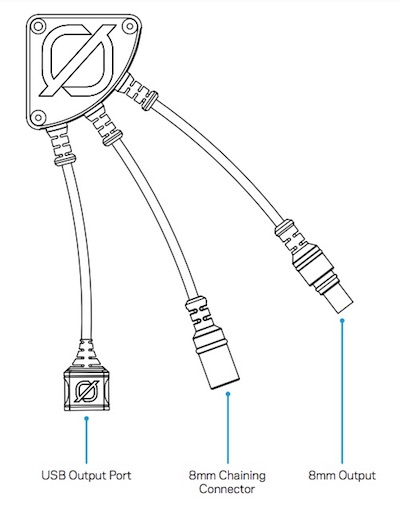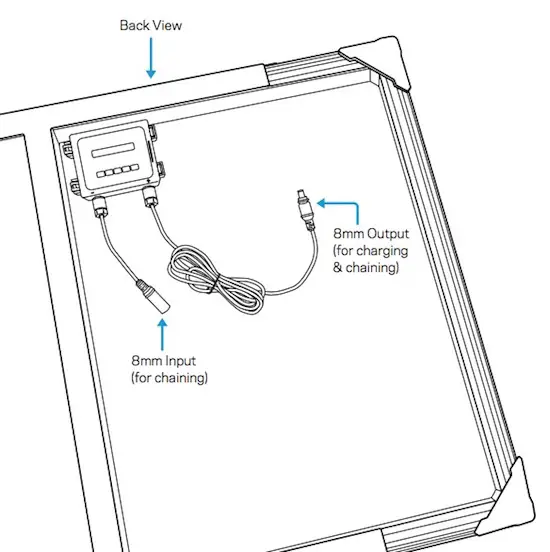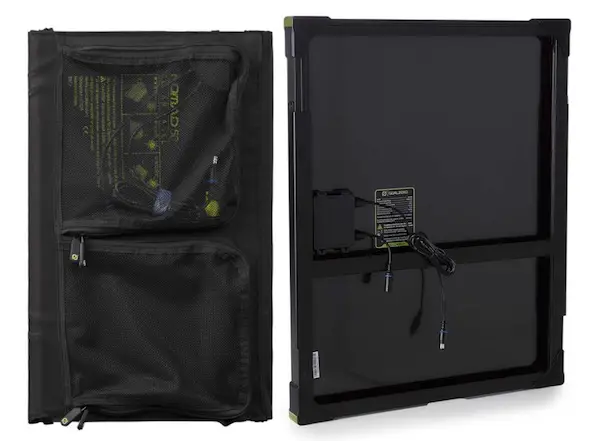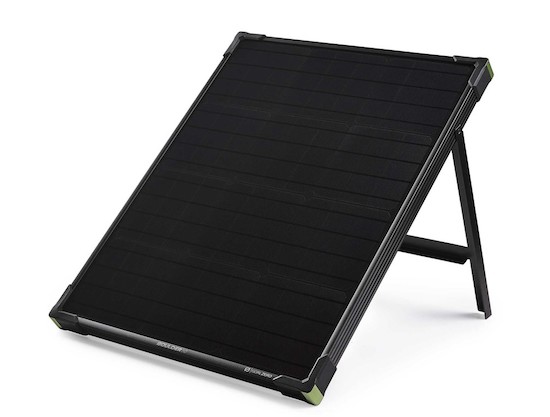The two products under review and comparison today are the Nomad 50 and Boulder 50 solar panels.
They offer the same amount of watts but have several differences in terms of weight, size, and portability, among other features.
The Nomad 50 is better than the Boulder 50 because it is foldable and is 6 lbs lighter. When folded, the Nomad 50 can be stored in a backpack, whereas the Boulder 50 is not foldable. There are several differences in each panels’ construction, making them ideal for different purposes.
| Model | Nomad 50 | Boulder 50 |
|---|---|---|
| Brand | Goal Zero | Goal Zero |
| Dimensions | Unfolded: 17 x 53 x 1.5 in Folded: 17 x 11.25 x 2.5 in | 21.75 x 26.75 x 1.75 in |
| Weight | 6.85 lbs | 12.4 lbs |
| Rated Power | 50 watts | 50 watts |
| Warranty | 12 months | 12 months |
| Price | $249.95 | $149.95 |
Nomad 50 Review and Analysis
The Nomad 50 is a sturdy device that is perfect for off-grid adventures. It is too big for most people to place on the back of their backpacks, but it is a great tool to have when using it for camping purposes or any other off-grid scenario where you need portable power.
Nomad 50 Specifications
| Model | Nomad 50 | |||
|---|---|---|---|---|
| Solar Cell Output | 50W | |||
| Power Output to Device | Solar Port (blue, 8mm, male): 14-21.5V, up to 3.3A (50W max) USB-A Port: 5V, up to 2.4A (12W max) | |||
| Dimensions | Unfolded: 17 x 53 x 1.5 in (43.2 x 134.6 x 3.8 cm) Folded: 17 x 11.25 x 2.5 in (43.2 x 28.6 x 6.4 cm) | |||
| Weight | 6.85 lbs | |||
| Cost | $249.95 |
Just as with most products from Goal Zero, the Nomad 50 is very rugged and durable, which makes it well suitable for use at the campsite or anywhere else you need an option to generate power.
The Nomad 50 weighs 6.85 pounds (3.1 kg). This is very light for a solar panel of 50W. It has four monocrystalline panels that fold into a 17 x 11.25 x 2.5-inch package for storing.
These are some additional features of the Nomad 50:
- Pairs with a Goal Zero Sherpa 100AC power bank or Yeti portable power stations (such as the Yeti 150, 400, 400 Lithium, 500X, among others)
- Hanging loops on the sides of the panel to mount
- Multiple panels (150W max) can be linked together to maximize power collection and reduce recharging time
- A USB-A output, 8mm output, and 8mm chaining cable for chaining multiple solar panels together

The Nomad 50 also has two zippered mesh storage pockets for storing cables and any other essentials you may need to be packed away.
The 8mm output on the panel measures out at six feet long, so you can easily charge a Yeti solar generator while getting ideal sunlight to the panel. You can also get a 30-foot extension cord (sold separately) that will extend your range with the system.
This may be ideal if you don’t want to have your solar generator in the sun while the panel is in use. There is also a USB-A output port on the panel which is rated at 12W maximum.
Boulder 50 – Analysis and Review
The Goal Zero Boulder 50 solar panel features a rugged look and a compact design. It is an efficient solar panel from Goal Zero’s Boulder series with tempered glass, an aluminum frame, reinforced corners, and a maximum power output of 50 watts. The Boulder 50 comes with a sturdy kickstand to angle your panel towards the sun, getting the most output from the panel as possible.
The Sherpa 100AC power bank and all Goal Zero solar generators can be connected to the Boulder 50 via its 8mm output. You can connect the Boulder 50 to a second and even third Boulder 50 to improve charging speeds. This is accomplished via its 8mm chaining capability. The 8mm cable allows for multiple panels to be connected in parallel, allowing for a consistent 12V output.

Like the Nomad 50, the Boulder 50 has a six-foot 8mm output cable. Since the 8mm output is the only output on the Boulder 50, you will need to purchase an adapter separately to connect the panel to anything other than a Goal Zero solar generator or Sherpa 100AC power bank.
Boulder 50 Specifications
| Model | Boulder 50 | ||||||
|---|---|---|---|---|---|---|---|
| Solar Cell Output | 50W | ||||||
| Power Output to Device | Solar port (blue, 8mm) output: 14-22V, up to 3.5A (50W max) Solar port (blue, 8mm) input chaining: up to 150W total | ||||||
| Dimensions | 21.75 x 26.75 x 1.75 in | ||||||
| Weight | 12.4 lbs | ||||||
| Cost | $149.95 |
You can also get mounting brackets for the Boulder 50 to mount your solar panel to a vehicle, roof, or any other unoccupied space that gets a lot of sunlight. These mounting brackets (Amazon affiliate link) are sold separately.
The Boulder 50 is an extremely rugged solar panel that has two capabilities: mounting on rooftops and utilizing its kickstand to use for off-grid excursions.
Since it is built with aluminum, tempered glass, and has reinforced corner protection, the Boulder 50’s 12-pound weight makes it a bit of a hassle to carry around for long distances. This is not the intended use of this solar panel. Mountable and portable solar panels differ in many ways. Portable solar panels can fold and be stored easily. This is a small mountable solar panel, which gives it a little more versatility when using it as opposed to the bigger mountable Boulder solar panels.
Pairing a Goal Zero Solar Panel (Boulder & Nomad)
As a whole, Goal Zero solar panels either have a USB-A, 8mm, or Anderson Powerpole output. When pairing it with a Goal Zero portable power station, check the inputs of the model you intend to buy, and confirm whether the outputs of the solar panel match the inputs of the portable power station.
The Nomad and Boulder 50 have a lot in common, but they also have a few different features and applications that make them ideal for different needs. You can pair both devices with the following Yeti solar generators and get the following charge times:
- Yeti 150: Charges in 5-10 hours
- Yeti 200X: Charges in 5-10 hours
- Yeti 400: Charges in 12-24 hours
- Yeti 400 Lithium: Charges in 13-26 hours
- Yeti 500X: Charges in 12-24 hours
- Yeti 1000 Lithium: Charges in 32-64 hours
- Yeti 1400 Lithium: Charges in 44-88 hours
The ideal use for a single Nomad or Boulder 50 is with a Yeti 500X or smaller portable power station from Goal Zero. The charging times for larger solar generators than the 500X are very long and may not be ideal for you.
Wattage Comparison – Nomad 50 vs Boulder 50
Both the Nomad 50 and Boulder 50 are rated for 50 watts of output. This does not mean that you will get a full 50 watts of power from the panels. As with all solar panels, it is best practice to count for efficiency losses to 80%. At this rate, the Boulder and Nomad 50 will produce about 40 watts of maximum power.
Additionally, to get the full capabilities of your solar panels, make sure they are aligned perpendicular to the sun.
The one feature that gives the Boulder 50 an advantage in this comparison is its kickstand. The Nomad 50 doesn’t have one, so it will take some additional work to make sure it is angled correctly towards the sun.
The Nomad 50 does come with hanging loops, however, when the Boulder 50 does not. This can give you the advantage of hanging the Nomad 50 on anything that can give you ideal sunlight. This includes areas like car rooftops, on the side of vehicles, on tents, among other options.
With the mounting brackets (sold separately) on the Boulder 50, you can mount it on several areas like rooftops, vehicles, and sheds. This is important because you can permanently install these panels if you’d like. They can also be removed to use the panel remotely.
Expandability of the Nomad 50 & Boulder 50
Both the Nomad 50 and Boulder 50 can have up to three of their solar panels connected to each other. This is done by using the chaining cables that come with each solar panel and connecting them to the additional panels.
You can also mix in the Boulder 100 solar panel and connect that to either solar panel to create the same 150W solar setup.
You can expand your solar panel array to greater than 150W total, but as stated in the Boulder 50 manual, “If you’re chaining more than three Boulder 50 Solar Panels together, or any configuration over 150W, you will need to purchase a combiner cable from Goal Zero.” This also applies to the Nomad 50.
With four 8mm inputs, you can connect four solar panels to the chaining cable (Amazon affiliate link) to charge a Goal Zero solar generator with an Anderson Powerpole input. You can also use third-party solar generators with this setup as long as they have Anderson Powerpole inputs.
Nomad 50 vs Boulder 50 – Weight/Size/Portability
The Nomad 50 is about six pounds lighter than the Boulder 50 panel.
This makes it a preferable choice when weight is a concern.
The Nomad 50 has several hanging loops on its sides that make it easy to mount when unfolded.
You can simply use clips or zip ties to attach it to any available space that can securely mount the panel.
With a weight of over 12 pounds, the Boulder 50 is not meant for constant transport by foot.
It is the most portable Boulder solar panel from Goal Zero because it is the smallest, however, it is still bulky when compared to the Nomad 50’s ability to fold into a small package.
When unfolded, the Nomad 50 is much longer than the Boulder 50’s frame.
The Boulder 50 is sized in a square-like shape, making it wider than the Nomad 50 panel.
The Boulder 50 does not come with a carrying handle like the Boulder Briefcase solar panels do, but Goal Zero sells a case that you can buy separately for the Boulder 50, called the Small Boulder Travel Case.
It can fit up to two Boulder 50s or one Boulder 100 Briefcase solar panel inside of it.
Similar: The #1 Fastest Charging Solar Power Bank
Durability of the Nomad & Boulder 50 Solar Panels
A durable solar panel will last long and be able to withstand rugged environments. Even though the Nomad 50 and Boulder 50 have the same solar output, they are constructed completely differently.
How long solar panels are going to last depends on usage and maintenance. When solar panels are properly used and taken care of, they tend to last much longer regardless of what materials they are made of.

Solid panels like the Boulder 50 are built to withstand harsh weather conditions with ease. Although the Nomad 50 is built with rugged use in mind, it isn’t the kind of panel you buy to leave out at all times.
As a whole, all Goal Zero solar panels are not waterproof. Their Nomad and Boulder series solar panels are waterproof on one side – the side where the solar panels are exposed. On the back of each solar panel, the wires are exposed, therefore causing them to not be entirely waterproof.
The Boulder 50 can be left out in the rain or shine, and in nearly any harsh weather conditions as long as the inputs and outputs of the panel are secluded from these conditions.
The same can be said of the Nomad 50, as the solar panel side of the system is completely waterproof. However, the back of the solar panel exposes its wires/cables and is not waterproof. As long as the panel is angled in a way where its backside is void of the rain, it can be successfully used.
Pricing – Nomad 50 vs Boulder 50
The Nomad 50 costs $249.95 (Amazon affiliate link), and Goal Zero also offers payment installments at $23/monthly for 12 months.
The Boulder 50 costs $100 less than the Nomad 50, at $149.95 (Amazon affiliate link). Goal Zero also offers monthly payments at $14/month for 12 months.
You can also use the monthly payment method for three and sixth months if that works better for you.
The main reason why I think the Nomad 50 is $100 more than the Boulder 50 is that it is more versatile. It simply has more applications of use than the Boulder panels. Since it is lighter and more compact, there are more outdoor applications for its use.
The Boulder 50 is not as portable, yet it is light enough to be portable if needed. Foldable solar panels are more expensive than mountable ones in general for these reasons.
Warranty and Customer Service – Nomad vs Boulder Panels
The Boulder 50 solar panel has a 24-month warranty. The Nomad 50 has a 12-month warranty. For any questions on either solar panel or if you have an issue, you can email or call Goal Zero’s support staff to help solve any issue you may have.
There are also “Q&A” sections on both the Nomad 50 and Boulder 50 listings on Goal Zero’s website to gain more insights or ask a question on the capabilities of these panels.
Conclusion – Nomad 50 vs Boulder 50 – Which Is the Winner?
The Nomad 50 is the ideal option to have over the Boulder 50 solar panel. This is because it is lighter, more portable (because it folds), and it has a USB-A output in addition to its 8mm output. The Boulder 50 is cheaper, can be mounted, and has a longer warranty, but it lacks in portability.

When you need a solar panel to be mounted, the ideal one to get is a 100-watt panel because you’ll simply get more power to whatever you’re charging.
Odds are that when you’re going to mount a solar panel, you’re going to use it to charge a battery or solar generator.
Since most of Goal Zero’s solar generators can take in more than 50 watts of solar panel input power, the Boulder 50 is not the best option to have unless you need it to fit in a small space on the roof of your home or vehicle.
The Nomad 50 can be stored easily and can be used in several environments outdoors, whereas the Boulder 50 is not ideal to use when moving long distances on foot.
You can simply place the folded Nomad 50 in your backpack when hiking and then unfold it when you’re at your desired destination.
Find the Nomad 50 here and the Boulder 50 here on Amazon. Both links are affiliate links, where I make a small commission on every sale.
If you’re looking for a higher-powered solar panel comparison, the Nomad 200 and Boulder 200 panels are two of Goal Zero’s largest panels.
You can read my comparison post that dives deeper into each one’s features here: Goal Zero Nomad 200 vs Boulder 200 (Complete Breakdown).
Continue Reading:




